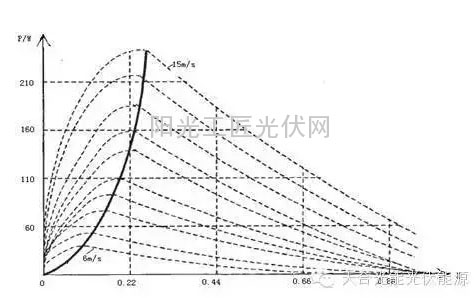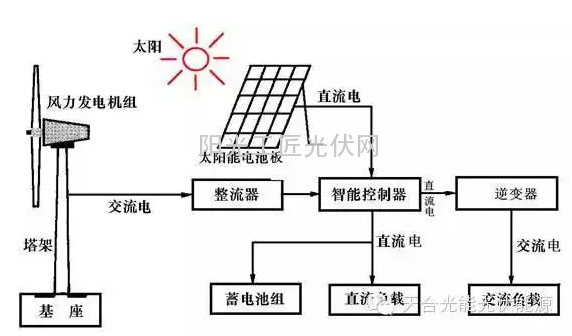Abstract: Based on the "3D (Direct-current/Direct-current/Duty-ratio)-△D" technique, a novel MPPT (Maximum PowerPoint Tracking) intelligent control facility for wind-solar hybrid power generation system is developed. The experimental results show that the developed “3D-△D†MPPT intelligent control facility is not only easy to control, simple, sensitive, accurate, but also new, advanced, practical and economical. The "3D-△D" MPPT control facility has been operating steadily at the Nantong Institute of Technology's new energy application technology training base. 1 Introduction Wind-solar hybrid power generation system can make full use of wind energy and solar energy resources to generate electricity. During the day, it may have better solar energy resources, and at night it may have better wind energy resources. In particular, there are regions where solar energy and wind energy are abundant and complementarity. The economic and social benefits are considerable. In order to overcome the uncertainties of wind energy and solar energy, resulting in unbalanced power generation and power generation of the system, and further enhancing the robustness of the wind-solar hybrid power generation system, it is necessary to create an excellent control facility to automate MPPT (Maximum PowerPoint Tracking) to control power generation and power regulation. Load merging is an optimal system. 2. MPPT control methods for wind power facilities Wind power generation facilities commonly used MPPT control methods are: discrete iteration MPPT control method, wind speed automatic tracking MPPT control method, wind turbine speed feedback MPPT control method; these methods are not cost-effective. For this reason, this article has developed a "Direct-current/Direct-current/Duty-ratio" MPPT control method with high performance-to-price ratio. The so-called "3D" control method, that is, through the controller's software and hardware facilities, generates a PWM signal of the duty cycle adjustable driving power switch tube, so as to achieve automatic adjustment of the system output voltage and current, and at any time to detect the wind generator voltage And compare with the safe voltage value that the controller set up: If is higher than the safe voltage value, regulate the voltage of the generator through the power switch tube that is in series among them. In addition, when the storage battery is fully charged or when there is strong wind (ie exceeds the rated wind speed of the wind turbine), the unloading circuit is started to perform unloading to ensure the safety of the system facilities. Wind turbine generators are connected to the load via a rectifier and a DC-DC (Direct-Current/Direct-Current) converter. The sampling facility completes the sampling of voltage and current. The MPPT control algorithm adjusts the output power of the generator according to the difference between the current power value and the power value of the previous sampling time, so as to achieve the MPPT target. This "3D" MPPT control method is based on the theory of "maximum power obtained by impedance matching": that is, when the load equivalent resistance of the linear circuit is equal to the internal resistance of the power supply, the maximum power can be obtained by the load. Impedance conversion is performed so that MPPT can be achieved by maintaining the system impedance matching status (in fact, only "quasi-matching" condition) by "3D" MPPT control method. The characteristic curves of the output power P and the DC/DC duty cycle D of the wind turbine are shown in Fig. 1. It can be seen from Fig. 1 that each wind speed (this figure only shows the wind speed from 6m/s to 15m/s). Each of the 10 wind speeds corresponding to the PD curve corresponds to a unique maximum power point. 3. MPPT control method for solar (photovoltaic) power generation facilities The output power of solar (photovoltaic) power generation is not only related to the sunshine intensity and temperature, but also related to the working voltage of the photovoltaic cell module. It is only possible to optimize the maximum power point by operating it at a specific working voltage. The MPPT control method and facility for photovoltaic power generation is to study how to make a photovoltaic cell module operate at a specific operating voltage. Photovoltaic cell module IV characteristics and PV characteristics are shown in Fig. 2. It is obvious that the maximum output power point varies with the environment. [3] By adjusting the operating point of the photovoltaic cell module in real time, it can always be operated near the maximum output power point. This is the efficacy goal of the photovoltaic power generation facility MPPT. Currently widely used MPPT methods in photovoltaic power generation facilities are: constant voltage method, perturbation method, conductivity increment method, etc. However, the cost-effectiveness of these methods is not high. How to optimize a cost-effective method is of utmost importance. The ΔD (ie, dynamic change of the duty cycle D) method developed in this paper is created in this context. The basic mode of this method is Dm=Dm-1+ΔD. , where Dm and Dm-1 are the duty cycles for the mth and m-1 moments, respectively. If △D fixed step length is not changed, when △D is selected too large, it is easy to cause oscillation; and if △D is selected too small, the dynamic performance of MPPT becomes worse. The research in this paper shows that if △D is a variable, it can solve the above problems that are fixed and invariable. Because even for the same system, the choice of △D has great influence on the dynamic and steady state performance under different conditions. By dynamically changing the △D value, the MPPT optimization can be realized quickly. The output power of photovoltaic facilities is PPV = U2PVD2/Rl (when excluding efficiency), where UPV and Rl are the output voltage and load equivalent resistance of the PV installation respectively. It can be seen that if the load is constant, PPV is proportional to D2 (because In practice, UPV basically remains unchanged. Therefore, the choice of △D is crucial to the system performance. In order to make the system adaptable, the parameters are automatically set by the modulo at the time of initialization. This article through a large number of theoretical research and experimental research results show that: D the best update rule for Dm = Dm-1 + BDA, where A = UPV△D + D △ UPV, and BD initialization can be based on the initial state of the model Automatically set (ie, BD=-ΔD/A-), so that only the photovoltaic cell module output voltage needs to be detected. According to the system operating state, ΔD iteration can be performed, so that the MPPT sensitivity can be improved. Because the step size is calculated automatically according to the state of the detection system, the system can be applied to different occasions without manually setting the initial value of the step length, which is very convenient. 4.3D-△D method of facilities The basic structure of the wind-solar hybrid power generation system involved in wind power and photovoltaic MPPT control method (ie "3D-△D" method) studied in this paper is shown in Fig. 3, which is mainly composed of wind turbines and solar (photovoltaic) cell arrays. , Intelligent controllers, inverters, rectifiers, battery packs and other components, among which the intelligent controllers mainly include control core DSPs, switch tubes, “3D-ΔD†regulators, liquid crystal display LCDs, PWM signal drive circuits, sampling/detection Circuits (ie wind generator voltage and current detection, photovoltaic cell array voltage and current detection, inverter voltage and current detection, battery voltage and charge and discharge current detection, temperature detection) and other devices. The system can supply AC and DC loads. 5 Conclusion When MPPT is performed on this wind-solar hybrid power generation system, wind power and photovoltaic can share a set of “3D-△D†facilities, which can not only greatly reduce the system cost but also simplify the control strategy. Moreover, the technology of “soft and hard†can be adopted by DSP. Means to regulate, that is, in the power switch on the gate to generate the corresponding PWM drive signal to adjust the duty cycle of the switch to achieve the intelligent control of the MPPT. The wind-solar hybrid power generation system has been successfully developed and it has been operating for more than one year at the new energy application technology experimental training base of the Nantong Polytechnic Institute of New Energy Engineering. The operation is very robust; and it is also applied to wind power generation facilities and photovoltaic power generation facilities respectively. The on-line measurement and operation were performed on the wind-solar hybrid power generation facilities. The output powers of these three facilities were detected by the data acquisition module as shown in Table 1. Table 1 shows that the photovoltaic output power and wind power output power are affected by external factors. The MPPT facility based on the "3D-△D" control method can quickly and accurately track changes in the external environment, so that the output power of the system is basically maintained at the maximum output power, that is, the robustness of the system power generation is better; and No "power oscillation" phenomenon occurs near the maximum power point of the system output power. corn wet milling process, after germ gluten, starch are separated, the fiber is separated out, dosed with some corn slurry, then dried through revolving barrel contacting methed.It contains starch, cellulose and other oligossachride, meanwhile it have rich dissolvable protein and its degradable substance, such as peptide hormone, various amino acid and so on. Besides, it contains lactic acid, phytin salt, dissolving sugar, all these constitute a nutritional products.
It is good feed for phytophage livestock (cattle, sheep, and fish), also good for pig, chicken and other single stomach animals. 3-5% dosage in feed could provide the nutrition factors the animal need, but also promote the health of digesting system.
Corn Gluten Feed (CGF) Corn Gluten Feed,Corn Gluten Feed For Pig Feed,Cgf 18 For Pig Feed,Con Gluten Feed 18 MIDI FEED BIOTECH LIMITED , https://www.chinabromine.com
Fig. 1 P-D characteristic curve of wind turbine 
Figure 2 IV and PV characteristics of PV module 
Figure 3 Basic structure of wind-solar hybrid power generation system 
Table 1 Output power of three facilities of wind-solar hybrid power generation system
Development of MPPT intelligent control device for wind-solar hybrid power generation system